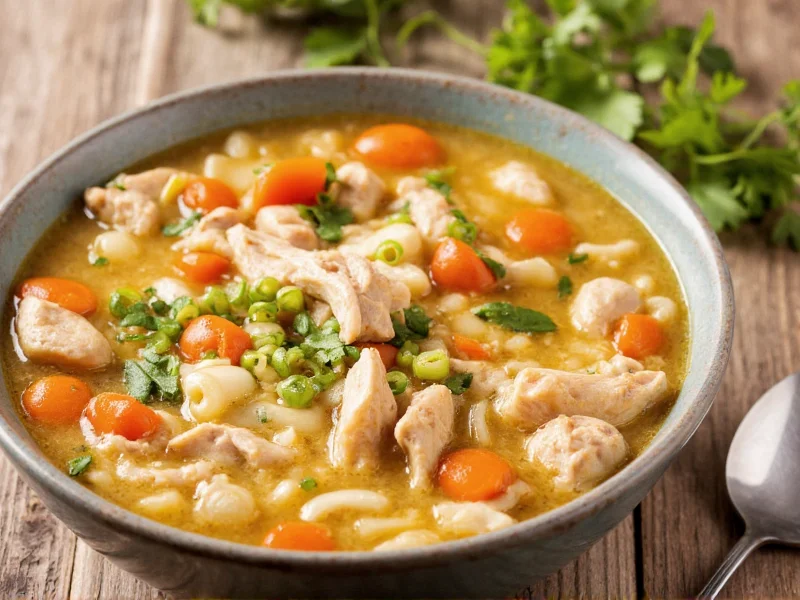Why Whole Chicken Makes Superior Soup
When crafting authentic chicken soup, starting with a whole chicken rather than pre-cut parts offers distinct advantages that elevate both flavor and nutrition. Professional chefs and home cooks alike recognize that the complete anatomy of the bird contributes to a more complex, satisfying end product.
The magic happens through the slow extraction of collagen from bones, cartilage, and connective tissues. As these components break down during simmering, they transform into gelatin, giving the broth its characteristic body and mouthfeel. This process simply doesn't occur to the same degree when using only breast meat or other isolated parts.
Key Benefits of Using Whole Chicken
Understanding the specific advantages helps explain why traditional recipes call for the entire bird:
- Enhanced flavor complexity - Different parts contribute unique flavor compounds
- Nutritional completeness - Bones release minerals like calcium and magnesium
- Economic efficiency - One bird yields both broth and meat for multiple meals
- Superior texture - Natural gelatin creates that desirable 'coat-the-spoon' consistency
- Waste reduction - Utilizes the entire animal with minimal discard
Step-by-Step Whole Chicken Soup Recipe
This traditional method maximizes flavor extraction while ensuring tender meat. The process spans two stages: creating the broth and then preparing the final soup.
| Ingredient | Quantity | Preparation Notes |
|---|---|---|
| Whole chicken (3-4 lbs) | 1 bird | Organic preferred, remove giblets |
| Carrots | 3 medium | Peeled and roughly chopped |
| Celery stalks | 3 | With leaves, roughly chopped |
| Yellow onion | 1 large | Peel intact, quartered |
| Garlic cloves | 4 | Smashed, skin on |
| Fresh parsley | 1/2 cup | Stems included for flavor |
| Fresh thyme | 4 sprigs | Or 1 tsp dried |
| Bay leaves | 2 | Dried |
| Whole black peppercorns | 1 tsp | In a cheesecloth bag |
| Water | 3 quarts | Cold, filtered |
| Apple cider vinegar | 2 tbsp | Helps extract minerals from bones |
Broth Preparation (Stage 1)
- Place chicken in a large stockpot and cover with cold water (about 3 quarts)
- Add vinegar and let sit 20 minutes to begin mineral extraction
- Bring to a gentle simmer over medium heat (do not boil rapidly)
- Skim foam that rises to the surface during first 15 minutes
- Add all vegetables, herbs, and peppercorns
- Reduce heat to maintain a bare simmer (small bubbles barely breaking surface)
- Cover partially and simmer for 2-2.5 hours
- Remove chicken and set aside to cool
- Strain broth through fine-mesh sieve, discarding solids
- Skim excess fat from surface once broth has cooled slightly
Soup Assembly (Stage 2)
- Remove meat from cooled chicken, discarding skin and bones
- Shred or cube meat into bite-sized pieces
- Return broth to clean pot and bring to gentle simmer
- Add fresh vegetables (carrots, celery, onions) cut to uniform size
- Cook until vegetables reach desired tenderness (15-20 minutes)
- Add chicken meat back to pot
- Season with salt to taste (add late to prevent toughening meat)
- Add fresh herbs just before serving
Avoiding Common Whole Chicken Soup Mistakes
Even experienced cooks can encounter issues when preparing whole chicken soup. Understanding these pitfalls ensures consistent results:
- Boiling instead of simmering - Rapid boiling makes broth cloudy and can toughen meat. Maintain a gentle simmer where bubbles occasionally break the surface.
- Adding salt too early - Salt added at the beginning can draw out moisture from the meat, resulting in drier chicken. Wait until the final soup stage.
- Overcooking vegetables - Add delicate vegetables like peas or fresh herbs in the last 5 minutes to preserve texture and color.
- Skipping the skimming step - Removing the initial foam creates a cleaner-tasting broth. This impurity contains proteins that haven't coagulated properly.
- Using hot water initially - Starting with cold water allows for gradual extraction of flavors and proteins.
Storage and Reheating Techniques
Proper storage maximizes both shelf life and quality of your whole chicken soup:
- Refrigeration - Store in airtight containers for up to 4 days. The gelatin in whole chicken broth causes it to congeal when cold - this is normal and desirable.
- Freezing - Portion into freezer-safe containers, leaving 1-inch headspace. Properly frozen, it maintains quality for 4-6 months.
- Reheating - Thaw frozen broth in refrigerator overnight. Reheat gently over medium-low heat without boiling to preserve texture.
- Revitalizing stored soup - Add a splash of fresh water or broth when reheating, as some liquid evaporates during storage.
Customizing Your Whole Chicken Soup
Once you've mastered the basic technique, experiment with these variations:
- Asian-inspired - Add ginger, star anise, and soy sauce during simmering; finish with rice noodles and bok choy
- Mediterranean style - Include lemon zest, oregano, and white beans; serve with crusty bread
- Hearty winter version - Add root vegetables like parsnips and turnips; finish with a dollop of pesto
- Lighter summer variation - Use fresh dill and mint; add zucchini and fresh corn at the end
Maximizing Flavor Extraction
Professional techniques can take your whole chicken soup to the next level:
- Dry-brine the chicken - Salt the whole chicken 12-24 hours before cooking to enhance flavor penetration
- Roast bones first - After removing meat, roast bones at 400°F for 30 minutes before making second batch of broth
- Double-strain the broth - First through coarse sieve, then through cheesecloth for crystal-clear results
- Concentrate the broth - Simmer strained broth an additional 30-60 minutes to intensify flavor











 浙公网安备
33010002000092号
浙公网安备
33010002000092号 浙B2-20120091-4
浙B2-20120091-4